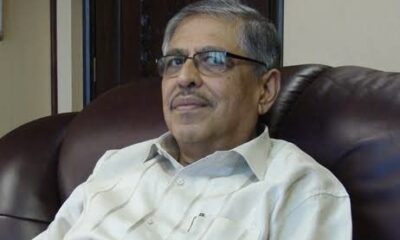News
What Will Decide The US Election and Why It’s So Close
Never in recent US political history has the outcome of a presidential been so in doubt – this is not a contest for the faint of heart.

(BBC)- Never in recent US political history has the outcome of a presidential been so in doubt – this is not a contest for the faint of heart.
While past elections have been narrowly decided – George W Bush’s 2000 victory over Al Gore came down to a few hundred votes in Florida – there’s always been some sense of which direction the race was tilting in the final days.
Sometimes, as in 2016, the sense is wrong. In that year, polls overestimated Hillary Clinton’s strength and failed to detect a late-breaking movement in Donald’s Trump favour.
This time around, however, the arrows are all pointing in different directions. No-one can seriously make a prediction either way.
A coin-toss
Most of the final polls are well within the margin of error, both nationally and in the seven key battleground states that will decide the election.
Based on statistics and sample sizes alone, that means either candidate could be ahead.
It is this uncertainty that vexes political pundits and campaign strategists alike.
There have been a smattering of surprises – not least one notable example, a recent respected survey of Republican-leaning Iowa giving Harris a shock lead.
But the major polling averages, and the forecasting models that interpret them, all show this as a coin-toss contest.
A clear winner is still possible
Just because the outcome of this election is uncertain, that doesn’t mean the actual result won’t be decisive – a shift of a few percentage points either way, and a candidate could sweep all of the battleground states.
If the voter turnout models are wrong and more women head to the polls, or more rural residents, or more disaffected young voters – that could dramatically shift the final results.
There could also be surprises among key demographic groups.
Will Trump really make the inroads with young black and Latino men that his campaign has predicted? Is Harris winning over a larger proportion of traditionally Republican suburban women, as her team is hoping? Are elderly voters – who reliably vote every election and tend to lean to the right – moving into the Democratic column?
Once this election is in the rear-view mirror, we may be able to conclusively point to a reason why the winning candidate came out on top.
Perhaps, in hindsight, the answer will be obvious. But anyone who says they know how things will turn out right now is fooling you – and themselves.
Blue Walls and Red Walls
In most US states the outcome of the presidential vote is all but certain. But there are seven key battleground states that will decide this election.
Not all battleground states are created equal, however. Each candidate has a “wall” of three states that offers the most direct path to the White House.
Harris’s so-called “blue” wall, named for the colour of the Democratic Party, stretches across Pennsylvania, Michigan and Wisconsin in the Great Lakes region. It has been the subject of much political conversation since 2016, when Trump narrowly won all three traditionally Democratic states on his way to victory.
Joe Biden flipped these states back in 2020. If Harris can hold them, she doesn’t need any other battleground, as long as she also wins a congressional district in Nebraska (which has a slightly different system in how it awards its electoral college votes).
That explains why she has spent the bulk of her time in these blue wall states during the campaign’s final stretch, with full days on the ground in each.
On Monday night, she held her final rally in Philadelphia, Pennsylvania, at the top of the 72 steps leading to the city’s Museum of Art, which Sylvester Stallone’s fictional boxer Rocky climbed in the film of the same name – before narrowly losing to his opponent, Apollo Creed.
Trump’s “red wall” sits along the eastern edge of the US. It is less talked about but equally important to his electoral chances. It starts in Pennsylvania but stretches south to North Carolina and Georgia. If he carries these states, he will win by two electoral votes, no matter how the other battlegrounds vote.
That explains why he’s held five events in North Carolina in just in the last week.
The overlapping point on each of these walls, of course, is Pennsylvania – the biggest battleground electoral prize. Its nickname, the Keystone State, has never been more appropriate.
America’s future in the balance
Sometimes lost in all this electoral map strategising and gameplay is the historic significance of this presidential election.
Harris and Trump represent two very different views of the US – on immigration, trade, cultural issues and foreign policy.
The president for the next four years will be able to shape American government – including the federal courts – in a way that could have an impact for generations.
The US political landscape has been changing dramatically over the past four years, reflecting shifts in the demographic make-ups of both parties.
The Republican Party of a decade ago looked very different to the populist one that Trump now leads, which has far more appeal to blue-collar and low-income voters.
The Democratic Party’s base still rests on young voters and people of colour, but it now relies more on the wealthy and college educated.
Tuesday’s results may offer additional evidence of how these tectonic shifts in American politics, only partially realised over the past eight years, are reshaping the US political map.
And those shifts could give one side or the other an advantage in future races.
It wasn’t too long ago – in the 1970s and 1980s – that Republicans were viewed as having a unassailable lock on the presidency because they consistently won a majority in enough states to prevail in the electoral college.
This election may be a 50-50 contest, but that doesn’t mean this is the new normal in American presidential politics.
Kenya Insights allows guest blogging, if you want to be published on Kenya’s most authoritative and accurate blog, have an expose, news TIPS, story angles, human interest stories, drop us an email on [email protected] or via Telegram
-

 Business2 weeks ago
Business2 weeks ago‘They’re Criminals,’ Popular Radio Presenter Rapcha The Sayantist Accuses Electric Bike Firm Spiro of Fraudulent Practices
-

 Business1 week ago
Business1 week agoIt’s a Carbon Trading Firm: What Kenyans Need to Know About Spiro’s Business Model Amid Damning Allegations of Predatory Lending
-

 Business1 week ago
Business1 week agoManager Flees Safaricom-Linked Sacco As Fears Of Investors Losing Savings Becomes Imminent
-

 News1 week ago
News1 week agoWoman Accused in High Defamation Blames AI As Case Exposes How Mombasa Billionaire Mohamed Jaffer Allegedly Sponsored Smear Campaign Linking Joho’s Family To Drug Trafficking
-

 Investigations2 weeks ago
Investigations2 weeks agoDisgraced Kuscco Boss Arnold Munene Moves To Gag Media After Expose Linking Him To Alleged Sh1.7 Billion Fraud
-

 Africa2 weeks ago
Africa2 weeks agoDisgraced Oil Trader Idris Taha Sneaks Into Juba as Empire Crumbles
-

 Investigations2 weeks ago
Investigations2 weeks agoFraud: How Sh235 Million Donor Cash For Nyamira Residents Was Embezzled Through Equity Bank Under Governor Nyaribo’s Watch
-

 Investigations1 week ago
Investigations1 week agoIntelligence Report Links Budding Politician James Mabele Magio To International Scammers Ring


















